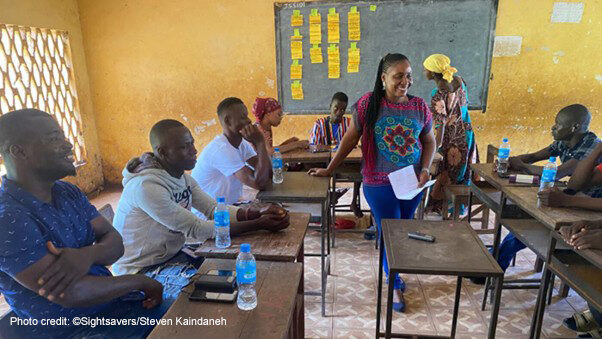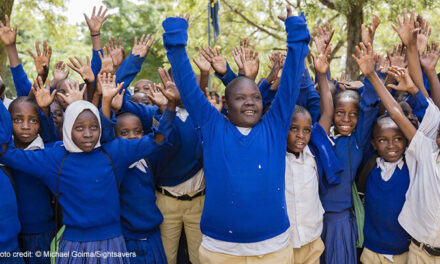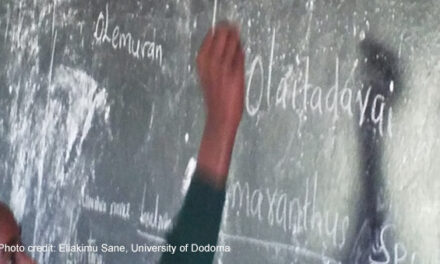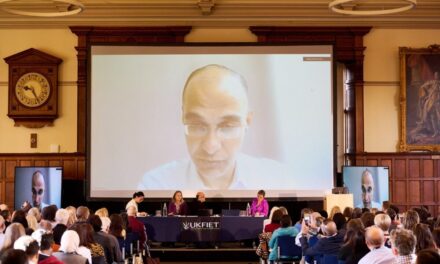This blog was written by Dr Steven Kaindaneh, technical support to inclusive education research at Sightsavers and the research study’s principal investigator; and Alexandre Chailloux, Sightsavers’ senior research associate in spatial analysis and study co-investigator. The blog was first published on the Sightsavers website in August 2025.
This research will be discussed in a session at the UKFIET September 2025 conference entitled: ‘Safely at school: Reducing the risks of school-related gender based violence for children with disabilities in Sierra Leone.’
This story map (Framing safety: maps and photos to share school experiences) shows how participatory mapping and photovoice has been used to explore school-related gender-based violence in four inclusive schools in Sierra Leone.
School-related gender-based violence affects more than 246 million children and adolescents around the world every year.
That’s a staggering number of young people facing abuse in an environment where they should be safe – and for children with disabilities, particularly girls, the risk is as many as four times higher than for their peers without disabilities.
As researchers working on SRGBV, we have seen firsthand how these experiences for children are often rooted so deeply that they have become part of everyday life. Usually, these children’s voices are missing from research and missing from discussions about how to address and prevent violence, reducing their agency even further.
This is exactly what our innovative research study in Sierra Leone aims to change. We’ve been making sure the voices and experiences of children with disabilities can guide our work to address school-related gender-based violence – and maps have played a key part in this work.
Community-based participatory action research
We’ve used a novel combination of participatory mapping, focus group discussions and photographic methods to put the perspectives of children with disabilities front and centre. Our research includes input from parents, teachers and community members to jointly develop response plans along with children with disabilities, setting out specific actions to address the challenges they face.
We trained youth with disabilities in each study community to contribute as young researchers, to ensure contextual relevance of the work, and support children in feeling safe and confident in sharing their thoughts and experiences. We used printed maps that the children used to identify places where they felt less safe but also where they felt safe. We purposefully worked outdoors, as this helped to make the children feel more comfortable in talking about such a sensitive subject.
The combination of research methodologies we’ve used has proved extremely powerful, enabling us to:
- Encourage children’s active participation by offering multiple ways they can get involved and share their ideas and experiences
- Generate rich, nuanced and geographically linked data reflecting children’s experiences in relation to a sensitive topic
- Create maps reflecting children’s perceptions and experiences, amplifying their voices and making their priorities visible
Our approach
We had the children gather around a large, printed map with their school at the centre. They responded with curiosity and enthusiasm and found new ways to express their experiences which had not emerged during the focus groups. The young researchers encouraged them to use sticky notes to highlight places on the map where they felt safe and where they felt at risk. This opened more space for children to describe the reasons for their feelings, and helped researchers identify patterns of violence and exclusion which otherwise might have gone unnoticed.
The maps became compelling evidence of the distribution of SRGBV and other safety risks around schools. They also brought children’s voices to life, giving them more agency and visibility in shaping the discussions around their safety.
Turning knowledge into action
The process clearly demonstrated that the children had something to say, and the maps have quickly become agents for initiating discussions on how to create safer schools.
Children have gained critical awareness of their environment and actively contributed to their own inclusion. Their maps are now challenging community and education decision-makers to take real action and translate the insights into change.
The visual and participatory nature of the maps have encouraged broader community involvement and collective reflection, which has led to the development of community action plans to reduce SRGBV. Plans developed by communities have included raising awareness on disability, strengthening bylaws on child abuse and making them functional, improving mechanisms for reporting SRGBV, making roads children use to and from school safer, and supporting girls with disabilities to stay in school.
As research on this topic develops, it is essential to ensure that the voices of children with disabilities can continue to be heard, and that policy and practice evolves to address their needs and concerns. This issue is too urgent and important to wait.





